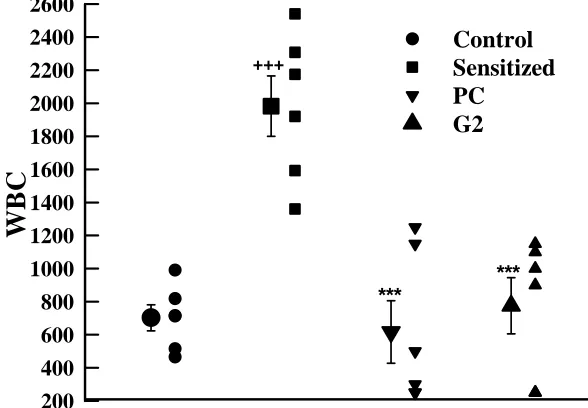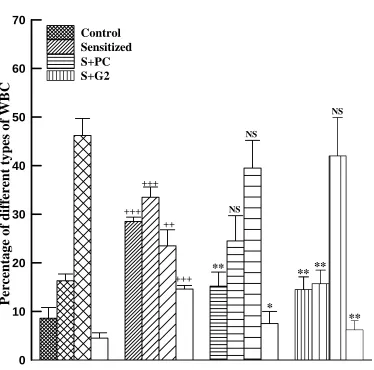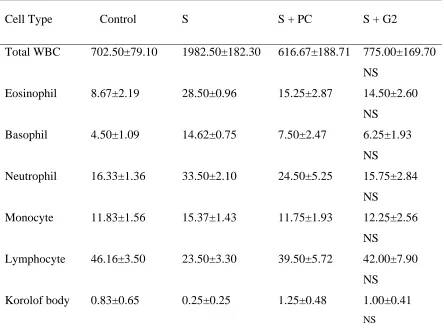THE EFFECT OF THE NATURAL ADJUVANTS ON CELL COUNT
IN LUNG LAVAGE OF SENSITIZED GUINEA PIGS
A. Neamati
1, M.H. Boskabady
2, J. Tavakol Afshari
3, S. Mohaghegh Hazrati
4, A.
Haeri Rohani
51-Dept. of Biology, Islamic Azad University ,Sciences & Research Unit, 2-Dept. of Physiology,
Medical School, Mashhad University of Medical Sciences 3-Dept. of Immunology, Medical School,
Mashhad University of Medical Sciences 4- School of Public Health , Tehran University of Medical
Sciences & Dr. Mohaghegh's Foundation Researches on Industrial Biotechnology 5-Dept. of Biology,
Islamic Azad University ,Sciences & Research Unit, IR Iran
Summary
Airway inflammation is the most characterized pathological feature in asthma. The anti-inflammatory effect of the adjuvants is reported. Therefore, the effect of two different natural adjuvants on white blood cells (WBC) of lung lavage of sensitized guinea pigs were examined. White blood cells count and differential WBC of lung lavage were examined in control and 3 groups of guinea pigs including:1) sensitized animals (S) , 2) sensitized animals treated with adjuvant PC (S+PC) and 3) sensitized animals treated with adjuvant G2 (S+G2), (n=4 for each group). Sensitization of animals were done by injection and inhalation of ovalbumin (OA). The results showed increased WBC count, eosinophil, neutrophil and basophil and decrease in lymphocyte in lung lavage of sensitized compared to control group (p<0.01 to p<0.001). However, both adjuvants caused significant preventive effect on changes in WBC count (p<0.001 for both cases). Both adjuvants also caused significant preventive effect on changes in eosinophil, neutrophil and basophil in lung lavage of sensitized animals (p<0.05 to p<0.001). These results indicate the preventive effects of two different natural adjuvants on increased WBC and changes in different WBC count of lung lavage in sensitized guinea pigs.
Key words: Natural adjuvant; Asthma; Lung inflammation; WBC
Running head: Effect of natural adjuvants on animal lung inflammation
Correspondence: M.H. Boskabady, M.D., Ph.D. Dept. of Physiology, Medical School, Mashhad, Post Code 91735, IRAN
Introduction
Asthma is an inflammatory disorder of the airway [1], and many inflammatory cells, including eosinophils, mast cells, macrophages and neutrophils, are involved in the pathogenesis of airway inflammation in asthma [2]. These inflammatory cells produce more reactive oxygen species (superoxides, hydrogen peroxide and hypohalites etc.) than do those obtained from normal subjects [3]. Reactive oxygen species directly contract airway smooth muscle preparations, and also appear to stimulate histamine release from mast cells and mucus secretion from airway epithelial cells [4].
It has been showed that oxidant stress results in inflammation and tissue damage in the respiratory system, and later in immune damage, and those individuals with lowered cellular reducing capacity are at increased risk to develop asthma [5]. In addition, T helper 2 system is activated in asthma disease, and its mediators cause many features of asthma such as airway inflammation, mucus secretion and airway hyperresponsiveness [6]. T helper 1 proved to inhibit T helper 2 response. Therefore one goal of asthma therapy should be focused on increasing the activity of T helper 1 system by natural immunomodulator [7]. Probiotics were known as cultures of potentially beneficial bacteria that positively affect the host by enhancing the microbial balance which can reduce the generation of proinflammatory cytokines [8].
The efficacy of PC and G2 adjuvants against cancer in animal model of breast cancer has been shown [9]. The stimulatory effects of these adjuvants on Th-1 cells have been also observed [10]. Therefore it seems that they could useful for treating or possibly prevention of many intra-cellular bacterial and viral disorders. They also suggested to have therapeutic effects on different illness like allergy and asthma [11]. Therefore, in the present in vitro
study, the effect of the PC and G2 adjuvants on cell count in lung lavage of sensitized guinea-pig was examined.
Materials And Methods Preparation of the adjuvants
PC Adjuvant also bacterial extract polypeptide and registered as a patent in the Iranian patent office as: Immune system Activator vaccine (Innovation Register No: 36681, 28th of October 2006). Briefly, PC were prepared from M. tuberculosis H37Rv cultured in Long's medium with some modifications. Microorganisms with surface pellicles were cultured for 10 days at 37°C, than re-cultured for 6 weeks. Microorganisms were then harvested and the killed particles were filtered in steam cabinet with different filters including berkefeld filters. Phenol (0.35%) + TCA acid (40%) were added to filtered materials and centrifuged at 850 g for 30 min. The product was washed three times with KH2PO4 and centrifuged at 4000 g for 30 min. The precipitated materials were dissolved in 0.5% Na2HPO4 and clarified by high speed centrifugation at 15000 g at 4°C for 4 hr. Supernatant was filtered in Berkefeld filter and added 0.5% phenol and diluted up to 2.5 µg per injection.
Animal sensitization
Sixteen adult Dunkin-Hartley guinea pigs (550 to 700 g) of both sexes were divided into four groups of 4 including: 1) control group, 2) sensitized animals (S) with OA alone (an animal model of asthma) receiving normal saline, 0.5 ml ip twice a week for 4 weeks, 3) sensitized animals treated with adjuvant PC, 0.1 ml ip twice a week for 4 weeks (S+PC) and 4) sensitized animals treated with adjuvant G2, 0.4 ml ip twice a week for 4 weeks (S+G2).
Sensitisation of animals to OA was performed using the method described byMcCaig [12, 13]. Briefly, guinea pigs were sensitised to OA (Sigma Chemical Ltd UK) by injecting 100 mg i.p. and 100 mg s.c. on day one and a further 10 mg i.p. on day 8. From day 14 sensitised animals were exposed to an aerosol of 4% OA for 18±1 days, 4 min daily. The aerosol was administered in a closed chamber, dimensions 30 x 20 x 20 cm. Control animals were treated similarly but saline was used instead of OA solution. The study was approved by the ethical committee of the Mashhad University of Medical Sciences.
Lung lavage and its white blood cells count
Control Sensitized PC
G2
WBC
200 400 600 800 1000 1200 1400 1600 1800 2000 2200 2400 2600
+++
***
***
(WBC) count was performed by neubauer lam using torch stain using non centrifuged BAL.
Statistical analysis
The data of total white blood cells (WBC) numbers and differential WBC counts were quoted as mean±SEM. According to the Kolmogorov Smirnov test, these data had normal distribution. The data of sensitized group were compared with control guinea pigs using unpaired "t" test. The data of two groups of animals treated with the adjuvants were also compared with sensitized guinea pigs using unpaired "t" test. Significance was accepted at p<0.05.
Results
White blood cell count
The mean value of total white blood cell (WBC) in lung lavage of S animals (1982.50±182.30) was significantly more than that of control group (702.50±79.10, p<0.001), (Fig. 2c). However, the WBC in S+PC (616.67±188.71) and S+G2 (775.00±169.70) groups showed improvement compared to that of S group (p<0.001 for both groups, Fig 1).
Differential count of WBC in lung lavage fluid:
There was a significant increase in percent of eosinophil, neutrophil and basophil (p<0.001 for all cases) and decrease in lymphocyte (p<0.01) in lung lavage fluid of S animals compared to those of controls. However, all the changes in eosinophil, neutrophil, basophil and lymphocyte seen in S group were reversed in both treatment groups which were statistically significant for eosinophil and basophil in both groups and for neutrophil in S+G2 (p<0.05 to p< 0.001, Fig 2).
Fig 2. The percentages of eosinophil (fine filled bars), neutrophil (medium filled bars), lymphocyte (coarse filled bars) and basophil (open bars) of lung lavage in control, sensitized (S), S treated with adjuvant PC (S+PC) and S treated with adjuvant G2 (S+G2) guinea pigs, (for each group, n=4). Statistical differences between sensitized and control group: ++; p<0.01, +++; p<0.001. Statistical differences between S+PC and S+G2 vs S group: NS: non significant difference, *; p<0.05, **; p<0.01, ***; p<0.001.
Percentage of diffe
rent types of WBC
0 10 20 30 40 50 60 70
Control Sensitized S+PC S+G2
* **
+++
+++ +++
++
**
** NS
** NS
Differences in different parameters between two groups of animals treated with the adjuvant
There was no any significant difference between the results of two groups (Table 1).
Table 1. Values of total white blood cells (WBC) and differential count of WBC in the lung lavage of control, sensitized (S), S treated with adjuvant PC (S+PC) and S treated with adjuvant G2 (S+G2) guinea pigs (for each group, n=4) and statistical differences between S+PC, S+G2 groups
Cell Type Control S S + PC S + G2
Total WBC Eosinophil Basophil Neutrophil Monocyte Lymphocyte Korolof body 702.50±79.10 8.67±2.19 4.50±1.09 16.33±1.36 11.83±1.56 46.16±3.50 0.83±0.65 1982.50±182.30 28.50±0.96 14.62±0.75 33.50±2.10 15.37±1.43 23.50±3.30 0.25±0.25 616.67±188.71 15.25±2.87 7.50±2.47 24.50±5.25 11.75±1.93 39.50±5.72 1.25±0.48 775.00±169.70 NS 14.50±2.60 NS 6.25±1.93 NS 15.75±2.84 NS 12.25±2.56 NS 42.00±7.90 NS 1.00±0.41 NS
Values are quoted as mean±SEM. Statistical differences in S+G2 vs S+PC: NS: non significant difference, * P<0.05.
Discussion
Prevention of leukocytosis and eosinophilia by the adjuvants in sensitized guinea pigs indicated anti-inflammatory effect of the adjuvants. In fact, the association between airway inflammation, epithelial damage, and airway hyperresponsiveness has been reported both in sensitized animals [14] and in asthmatic patients [15]. In addition, the existence of eosinophil in lung paranchyma, epithelial damage and increased tracheal responsiveness was demonstrated in our previous study, using the same method of sensitization of guinea pigs [16].
However, the exact mechanism(s) of action of these adjuvants are not well known. One proposed mechanism of action is its regulation of Th1 and Th2 cells balance. It is shown that the inflammatory condition is regulated by the balance of two mutually inhibited subsets of CD4+ helper T cells, Th1 and Th2 cells, which are classified on the basis of their cytokine profile. Th1 cells promote the activity of macrophages and regulate the pro-inflammatory response, whereas Th2 cells inhibit the activity of macrophages directly or indirectly by inhibiting Th1 activity and thus regulate the anti- inflammatory response [17]. The prevention effect of studied adjuvants on decreased lymphocytes of sensitized animals may support this hypothesis. In fact the stimulatory effects of these adjuvants on Th1 cells have been also observed [10].
The other mechanism of the effect of the adjuvant is their antioxidant effect. It was hypothesized that the uptake of antioxidants may slow down the Th1-type immune response and thereby favors an overproduction of Th2-type cytokines [18]. In fact foods rich in antioxidants may cause a lack of triggers for the Th1-type immune response [18]. In addition a relatively powerful preventive effect of vitamin C on increased tracheal responsiveness of sensitized guinea pigs with similar method of sensitization has been shown in our previous study [19]. However, the effect of the adjuvants on regulation of Th1 and Th2 cells balance and their antioxidant effect should be investigated in further studies.
Regarding to safety of these adjuvants, more than 10000 injections in rabbit, guinea pigs, BALB/c mice with different doses with different intervals and combinations of adjuvants were performed and no any side effects was observed in studied animals [unpublished data]. In conclusion, the results of the present study indicated preventive effects of two different natural adjuvants on changes in WBC and differential count of lung lavage of sensitized guinea pigs.
Acknowledgments
References
1. Busse W, Banks-Schlegel SP, Larson GL. Childhood versus adult-onset asthma. Am J Respir Crit Care Med 151: 1635-1639, 1995.
2. Kelly CA, Ward C, Stenton SC, Bird G, Hendrick DJ, Walters EH. Numbers and activity of cells obtained at bronchoalveolar lavage in asthma, and their relationship to airway responsiveness. Thorax 43: 684-692, 1998.
3. Cluzel M, Damon M, Chanez P. Enhanced alveolar cell luminol-dependent chemiluminescence in asthma. J Allergy Clin Immunol 80: 195-201, 1987.
4. Adler KB, Holden-Stauffer WJ, Repine JE. Oxygen metabolites stimulate release of high-molecular-weight glycoconjugates by cell and organ cultures of rodent respiratory epithelium via an arachidonic acid dependent mechanism. J Clin Invest 85: 75-85, 1990. 5. Greene LS. Asthma and oxidant stress: nutritional, environmental, and genetic risk
factors. J Am Coll Nutr 14: 317-324, 1995.
6. Cohn L, Elias JA, Chupp GL. Asthma: mechanisms of disease persistence and progression. Annu Rev Immunol 22:789-815, 2004.
7. Randolph DA, Stephens R, Carruthers CJ, et al. Cooperation between Th1 and Th2 cells in a murine model of eosinophilic airway inflammation. J Clin Invest 104: 1021-1029, 1999.
8. Del Giudice M.M., Rocco A., Capristo C. Probiotics in the atopic march: highlights and new insightsDigestive and Liver Disease 38 (Suppl 2): S288-S290, 2006.
9. Mohaghegh Hazrati S, et al . A novel an invasive metastatic Adenocarcinoma of breast cancer (HAZ-1) in small with laboratory mice. 14th Iranian Congress of Physiology and Pharmacology 262, 1999.
10.Mohaghegh Hazrati S, et. al. Effect of Auto-antigens and Th-1 activator adjuvants on pituitary adenoma of prolactinoma. 6th International congress of endocrine disorders. Iranian J Endocrine and Metabolism 22, 2001.
11.Mohaghegh Hazrati S., et al. G2, PC and G2F in allergic asthma. Iranian J Pediarics 13 (Suppl 2): 30, 2004.
12.McCaig D, De Jonckheere S. Effect of two Ca2+ modulator in normal and albumin sensitized guinea-pig trachea. Eur J Pharmacol 249: 53-63, 1993.
14.Padrid P, Snook S, Finucane T, Shiue P, Cozzi P, Solway J, Leff A. R. Persistent airway hyperresponsiveness and histologic alteration after chronic antigen challenge in cats. Am J Respir Crit Care 51: 184-193, 1995.
15.Booth H, Richmond I, Ward C, Gardiner PV, Harkawat R, Walters HE. Effect of high dose inhaled fluticasone propionate on airway inflammation in asthma. Am J Respir Crit Care Med 152: 45-52, 1995.
16.Boskabady MH, Kiani S. The effect of expouser of guinea pigs to cigarette smoke and their sensitization with ovalbumin in tracheal responsiveness to histamine and hisatamine (H1) receptor blockade by chlorpheniramine. Pathophysiology 14: 97-104, 2007.
17.Romagnani S. Th1/Th2 cells. Inflamm Bowel Dis 5: 285-94, 1999.
18.Murr C, Schroecksnadel K, Winkler C, Ledochowski M, Fuchs D. Antioxidants may increase the probability of developing allergic diseases and asthma. Med Hypotheses 64: 973-977, 2005.
19.Boskabady MH, Ziaei T. Effect of ascorbic acid on airway responsiveness in ovalbumin sensitized guinea pigs. Respirology 8: 473-478, 2003.


